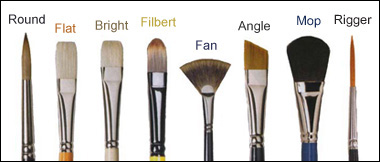If you’re an oil painter you know that there are a lot of oil painting brushes available to choose from—big, small, square, angled, and everything in between.
In the image above, you can see several common types of artist’s paintbrushes: Round, Flat, Bright, Filbert, Fan, Angle, Mop, and Rigger. Besides the differences in shape, some brushes use synthetic fibers, some use natural hair, and some paintbrushes have a blend of both.
Of course, each of those different types of paintbrushes come in several sizes. Some—like the Rigger—are around the size of a pencil tip, while others can be almost as large as a typical house painting brush.
All of it adds up to a wide array of options that leads new artists, or artists just getting into oil painting, to ask: “Which brushes should I buy?”
Well here’s my advice.
First of all, don’t listen to those “How to Paint Trees, Dogs, Landscapes, Etc.” books which tell you that you’ll need special brushes to paint certain objects.
That’s just rubbish. The skill to paint comes from your eyes, mind, and hands.
If you want to be an oil painter, you really only need two types of brushes in a few different sizes. Obviously, there’s nothing stopping you from buying sets of brushes, and you might even find use for each of them occasionally—but you don’t HAVE to have them, and anyone who tells you different is probably just trying to make a buck.
I suggest sticking with the basics: Flats and Filberts. Flat brushes will give you sharper edges when you paint, while Filberts will create softer more rounded strokes because of their shape.
I have six main brushes that I use; three of them are Flats and three are Filberts. They’re spread out in size, of course, with two size twelve brushes (one Flat, one Filbert), a middle pair that are sixes, and two small brushes that are twos.

Buying just those seven paintbrushes will cost you enough as it is, but if you’re bound and determined to get more, you might like having a Rigger or small Round to sign your paintings with.
If you’re wondering about the difference between Brights and Flats, they’ll both work about the same; I just go with the Flats because I like having more brush length to load paint onto.
And I honestly don’t have any use for the Fan, Mop, Round, or Angle brushes.
When it comes to synthetic versus natural, oil painting requires natural hair bristle brushes. Synthetic fibers are great for watercolor or inking, and can be used with acrylics occasionally, but they just aren’t tough enough to handle oil paint.
The average arts and crafts store might not have the best brushes (or paints for that matter) if you’re planning on using oils. Go to an established painting supply store or order online from a place like Blick Art Materials.
If you’re buying in person, run your thumb length-wise across the tip of each brush’s bristles to check it out. The hairs should be stiff and really snap back into place once you’ve finished. If they don’t, make sure it’s not made with synthetic fibers or just go look for a more expensive (but better) brand.
In general, I believe it’s always good to spend a little more on brushes. While buying great brushes won’t automatically make you a better painter, having poor quality ones will probably frustrate you and cause problems.
And remember—take good care of your paintbrushes and they’ll last a long time.
This post may contain affiliate links.

